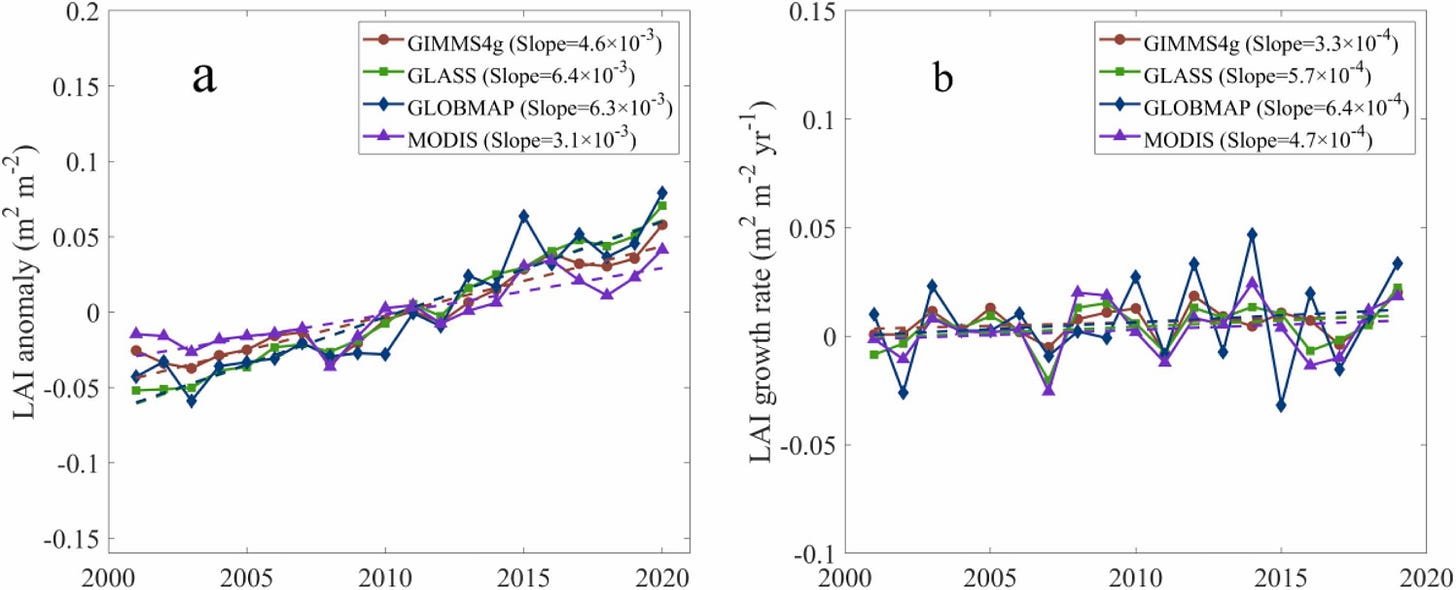Rethinking CO2...
The Benefits of Elevated CO2 on Society.
The increase in atmospheric CO2 levels, attributed primarily to human activities such as the burning of fossil fuels and land-use changes, is often discussed in the context of its role in driving climate change and its associated negative impacts. In fact, the mission statement of the IPCC explicitly states their focus on climate change risk…
The IPCC was created to provide policymakers with regular scientific assessments on climate change, its implications and potential future risks, as well as to put forward adaptation and mitigation options.
Source: https://www.ipcc.ch/#:~:text=The%20IPCC%20was%20created%20to,of%20knowledge%20on%20climate%20change.
However, there are also several aspects in which elevated CO2 levels have beneficial effects on society, which the IPCC and the MSM commonly ignore as they do not fit the narrative of a climate emergency. Here, I explore these benefits, focusing on agricultural productivity, plant growth, and potentially mitigating certain environmental challenges to show that elevated CO2 has had a net benefit on society to the present day.
Increasing evidence points towards the detrimental impacts of rising CO2 levels, notably the surge in extreme weather events and the resultant loss of life and financial costs, not being reflected in the observable data. Consequently, the overall effects of heightened CO2 levels could potentially result in a net positive for society, particularly if the negative effects have been grossly overestimated.
One of the most direct benefits of increased atmospheric CO2 is its effect on plant growth and agricultural productivity. This had been identified by NASA long ago…
But this result has been recently called into question with a 2019 study in Science, titled, ‘Increased atmospheric vapor pressure deficit reduces global vegetation growth’ which states:
In response, the vegetation greening trend indicated by a satellite-derived vegetation index (GIMMS3g), which was evident before the late 1990s, was subsequently stalled or reversed.
However, the most recent results published last month in Global Ecology and Conservation have confirmed NASA’s original findings, concluding:
Greening acceleration occurred in 55.15% of the globe (positive trend and positive growth rate trend), while browning acceleration occurred in only 7.28% (negative trend and positive growth rate trend). Combined with meteorological variables, we found that CO2 change dominated the LAI (leaf area index) trend, while climate change largely determined the LAI growth rate trend. Importantly, our study highlighted that drought trend did not necessarily trigger vegetation browning, but slowed down the rate of greening.
As many of us learned in elementary school, CO2 is a critical raw material for photosynthesis, the process by which plants convert light energy into chemical energy, using CO2 and water to create glucose, which fuels their growth and development. The CO2 fertilization effect refers to the enhanced growth of plants, including many crops important for human consumption, under elevated CO2 conditions. Studies have shown that crops such as wheat, rice, and soybeans can exhibit increased growth rates and yields in environments with higher CO2 concentrations.
Plants come in two main flavors when it comes to how they capture carbon dioxide for photosynthesis: C3 and C4.
C3 plants, like apples, oranges, strawberries, lettuce, spinach, carrots, potatoes, beans, lentils, soybeans, almonds, walnuts, peanuts, wheat, barley, rye, oats, potatoes, peas, lentils, flax, use a simple approach with a 3-carbon compound as their first product. The good news is that they thrive under higher CO2 levels, potentially doubling their yield if CO2 concentration reaches 800-1000 ppm.
C4 plants, like maize, sorghum, sugarcane, millet, and most grasses, are more efficient CO2 capturers, using a 4-carbon compound pathway. While they still benefit from increased CO2 (up to 25% yield increase at 800-1000 ppm), their response is less dramatic than C3 plants. They're also tougher and can handle CO2 levels up to 1800ppm without damage.
Interestingly, as the planet gently warms, the vegetation prefers higher CO2 concentrations.

The combination of modern farming machinery, synthetic fertilizers produced from fossil fuels, and CO2 fertilization has resulted in record crop yields globally, crucial for feeding the growing global population…
…and a significant decrease in the rate of people dying due to famine.
Higher CO2 levels can also improve plant water use efficiency, meaning plants lose less water through transpiration (the process of water movement through a plant and its evaporation from leaves) while still maintaining or even increasing their photosynthetic capacity. In fact, a study published in 2017 in Nature Communications found:
The increased water use efficiency is positively related to rising CO2 concentration and increased canopy leaf area index, and negatively influenced by increased vapour pressure deficits. Our findings suggest that rising atmospheric CO2 concentration has caused a shift in terrestrial water economics of carbon uptake.

This trait is particularly beneficial in arid and semi-arid regions where water is a limiting factor for plant growth. By improving water use efficiency, increased CO2 levels could help in the cultivation of crops in regions previously considered marginally arable, thus contributing to food security. Interestingly, crops such as wheat and corn have been shown to respond differently regarding water efficiency
This increase in agricultural yields and efficiency due to elevated CO2 levels, in addition to modern equipment and synthetic fertilizers, has had significant economic benefits. Higher productivity has led to lower food prices and increased food availability, contributing to economic stability and reducing extreme poverty globally.
Finally, the elephant in the room, and perhaps the most contentious point, is the shadow of another ice age looming on the horizon.








